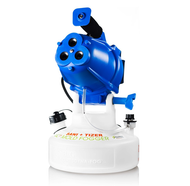Sanitizer Foggers: Are They Effective for Mold Remediation?
Aug 30th 2025
Every homeowner knows that mold and mildew are inevitable,especially if you do not regularly clean and disinfect certain areas in your home. Mold remediation is a process homeowners have to do to maintain the air quality and healthiness of their homes, and using a sanitizer fogger is one part of the process.
A fogger allows you to treat large and small areas alike, delivering a fine mist of mold solution concentrate to surfaces and into the air. But what makes fogging helpful for mold issues, and how do you prepare your space?
Here’s how to use the sanitizer fogger step by step, and why the EC3 Sanitizer Fogger and Mold Solution Concentrate is a leading choice for full-home coverage.
Why a Sanitizer Fogger Helps in Mold Remediation
A sanitizer fogger disperses a cleaning or mold solution as a fine mist, allowing it to reach areas a traditional sprayer cannot. The mist generated by a fogger penetrates fabrics, fills the air, and coats walls, floors, and ceiling surfaces.
This process helps treat airborne mold spores as well as those settled on hard-to-reach surfaces, making it especially valuable for individuals with mold sensitivities or ongoing mold exposure concerns.
One of the biggest advantages of using a fogger is the consistent and even application it provides. Unlike spray bottles that may miss areas or apply unevenly, fogging ensures a uniform layer of solution across everything.
It also reaches cracks, corners, behind furniture, and within fabrics—places mold spores often settle unnoticed. As a result, fogging helps reduce recurrence, neutralize odors, and improve indoor air quality over time.
Steps to Take Before Using a Fogger
Proper preparation is essential for effective fogging and helps ensure you get the best possible results. Before you start, it’s crucial to clean the space and remove any visible mold. This can be done with EC3 Mold Spray or a mold-specific surface cleaner.
Fogging is designed to handle spores and airborne particles—not to replace deep cleaning or professional remediation when mold growth is significant.
Once the major remediation of the cause of the mold is complete and cleaning of the area is done, remove sensitive items from the space, like electronics. . While the EC3 solution is non-toxic, overexposure to mist on electronics could lead to damage or unnecessary saturation. Clearing the space also helps the fog circulate more freely and cover surfaces more evenly.
Ventilation is another important step, especially after fogging. Good airflow helps surfaces dry thoroughly. After foggingturn on fans, or use a dehumidifier to speed up the drying process.
Where to Use a Sanitizer Fogger
Sanitizer foggers are suitable for use in nearly every room or area where mold may be a concern. They are ideal for treating entire rooms, including floors, ceilings, windowsills, and under furniture.
Fogging is also beneficial in confined areas like closets and car interiors, where spores often go unnoticed. HVAC vents and air returns are other high-risk zones, as they recirculate mold spores throughout the home.
When you fog these areas, you reduce airborne mold levels and help keep your system clean. In spaces with upholstered furniture, rugs, and drapes, fogging ensures deep penetration into fibers, which a surface wipe-down could never reach.
How to Use a Sanitizer Fogger Properly
To fog your space properly, begin by mixing the EC3 Mold Solution Concentrate according to the label instructions. Use distilled water ONLY, as this helps prevent residue or mineral buildup in the fogger.
Next, adjust the spray settings on the fogger based on the size of your space. For smaller rooms, a lower setting will suffice, while larger rooms may require higher output. Always hold the fogger on stable and use an extension cord to move freely around the space. This allows the mist to rise and naturally spread throughout the space.
Turn the fogger on and slowly move it in sweeping, up-and-down motions. The goal is even coverage—not targeted spraying or saturation. Be sure to avoid spraying directly on items that could become overly wet, like electronics or absorbent materials.
Allow the fogger to run until the solution is used or the desired coverage is achieved. Once complete, turn it off, empty any remaining solution, and clean the unit thoroughly. After fogging, allow treated items and surfaces to dry completely before re-entering or using the room.
Post-Fogging Care
After fogging, ventilation becomes your best friend. Open doors and windows, or use fans to assist in drying. Though the EC3 formula does not leave behind harsh chemical residue, it's best to wait until surfaces are fully dry before wiping or vacuuming to avoid disturbing the treatment.
Routine fogging is recommended every few weeks or once a month depending on the severity of mold issues. For homes with chronic moisture problems, additional interventions like fixing leaks, improving airflow, or running dehumidifiers are crucial. Fogging should always be part of a comprehensive mold strategy—not a standalone fix.
If you're tracking mold levels, post-fogging testing can help determine effectiveness and plan future treatments accordingly. This is especially useful for those with mold allergies or chronic inflammatory conditions related to mold exposure.
EC3 Sanitizer Foggers Complete Mold Remediation
Using a sanitizer fogger like the EC3 system is one of the smartest ways to enhance your mold remediation efforts. It allows for complete coverage of your home’s surfaces with a safe, effective mold solution, reaching areas that other cleaning methods simply cannot.
When paired with proper cleaning, drying, and moisture control, fogging can transform your indoor environment and help prevent future mold problems.
Visit MicroBalance now to make your mold remediation process more efficient!



